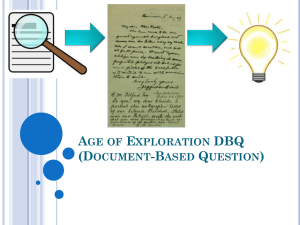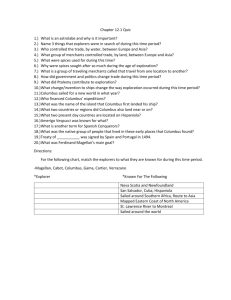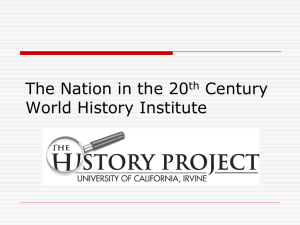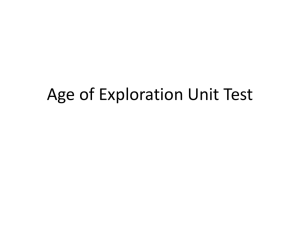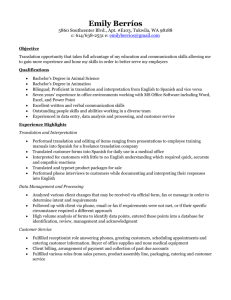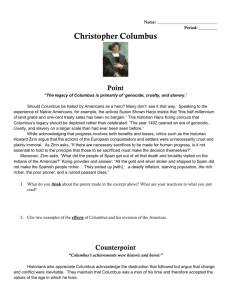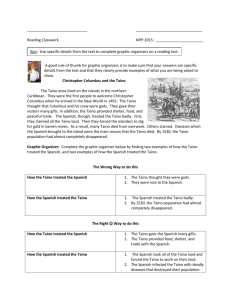Comparing and Contrasting Perspectives of *First Contact*
advertisement
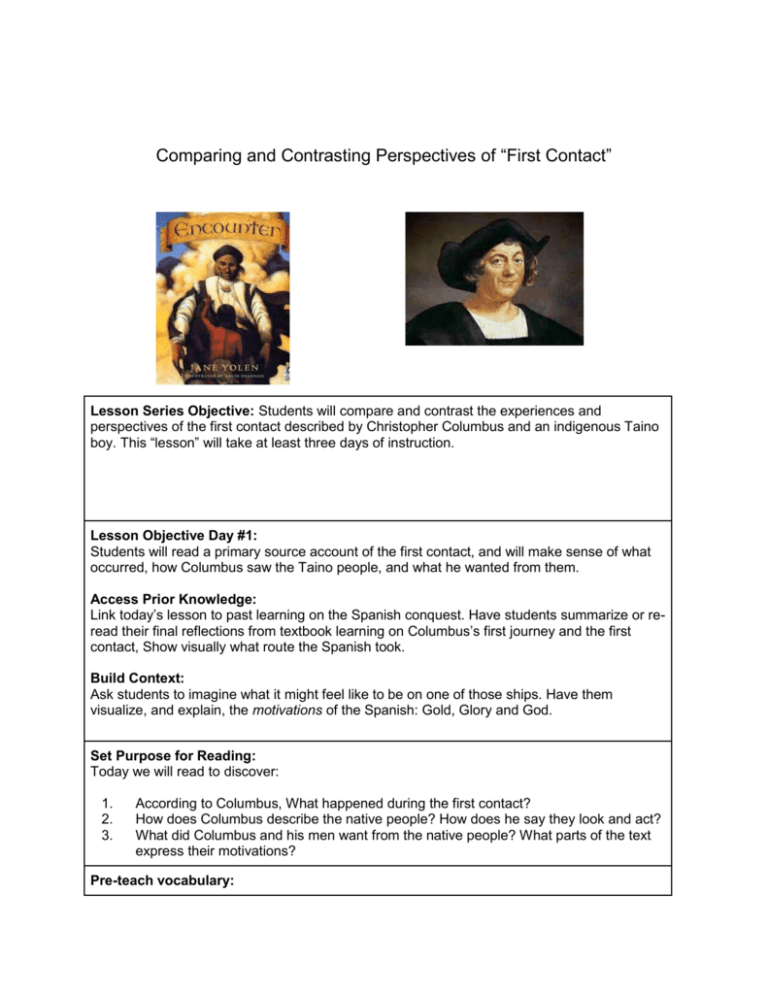
Comparing and Contrasting Perspectives of “First Contact” Lesson Series Objective: Students will compare and contrast the experiences and perspectives of the first contact described by Christopher Columbus and an indigenous Taino boy. This “lesson” will take at least three days of instruction. Lesson Objective Day #1: Students will read a primary source account of the first contact, and will make sense of what occurred, how Columbus saw the Taino people, and what he wanted from them. Access Prior Knowledge: Link today’s lesson to past learning on the Spanish conquest. Have students summarize or reread their final reflections from textbook learning on Columbus’s first journey and the first contact, Show visually what route the Spanish took. Build Context: Ask students to imagine what it might feel like to be on one of those ships. Have them visualize, and explain, the motivations of the Spanish: Gold, Glory and God. Set Purpose for Reading: Today we will read to discover: 1. 2. 3. According to Columbus, What happened during the first contact? How does Columbus describe the native people? How does he say they look and act? What did Columbus and his men want from the native people? What parts of the text express their motivations? Pre-teach vocabulary: galleon possession arms/armed sovereign Close Read of Text or Excerpts from this text: http://www.fordham.edu/halsall/source/columbus1.asp Text of Columbus’s journal, he quotes the experience of his Admiral, At two o'clock in the morning the land was discovered, at two leagues' distance; they took in sail and remained under the square-sail lying to till day, which was Friday, when they found themselves near a small island, one of the Lucayos, called in the Indian language Guanahani. Presently they descried people, naked, and the Admiral landed in the boat, which was armed, along with Martin Alonzo Pinzon, and Vincent Yanez his brother, captain of the Nina. The Admiral bore the royal standard, and the two captains each a banner of the Green Cross, which all the ships had carried; this contained the initials of the names of the King and Queen each side of the cross, and a crown over each letter Arrived on shore, they saw trees very green many streams of water, and diverse sorts of fruits. The Admiral called upon the two Captains, and the rest of the crew who landed, as also to Rodrigo de Escovedo notary of the fleet, and Rodrigo Sanchez, of Segovia, to bear witness that he before all others took possession (as in fact he did) of that island for the King and Queen his sovereigns, making the requisite declarations, which are more at large set down here in writing. Numbers of the people of the island straightway collected together. Here follow the precise words of the Admiral: "As I saw that they were very friendly to us, and perceived that they could be much more easily converted to our holy faith by gentle means than by force, I presented them with some red caps, and strings of beads to wear upon the neck, and many other trifles of small value, wherewith they were much delighted, and became wonderfully attached to us. Afterwards they came swimming to the boats, bringing parrots, balls of cotton thread, javelins, and many other things which they exchanged for articles we gave them, such as glass beads, and hawk's bells; which trade was carried on with the utmost good will. But they seemed on the whole to me, to be a very poor people. They all go completely naked, even the women, though I saw but one girl. All whom I saw were young, not above thirty years of age, well made, with fine shapes and faces; their hair short, and coarse like that of a horse's tail, combed toward the forehead, except a small portion which they suffer to hang down behind, and never cut. Some paint themselves with black, which makes them appear like those of the Canaries, neither black nor white; others with white, others with red, and others with such colors as they can find. Some paint the face, and some the whole body; others only the eyes, and others the nose. Weapons they have none, nor are acquainted with them, for I showed them swords which they grasped by the blades, and cut themselves through ignorance. They have no iron, their javelins being without it, and nothing more than sticks, though some have fish-bones or other things at the ends. They are all of a good size and stature, and handsomely formed. I saw some with scars of wounds upon their bodies, and demanded by signs the of them; they answered me in the same way, that there came people from the other islands in the neighborhood who endeavored to make prisoners of them, and they defended themselves. I thought then, and still believe, that these were from the continent. It appears to me, that the people are ingenious, and would be good servants and I am of opinion that they would very readily become Christians, as they appear to have no religion. They very quickly learn such words as are spoken to them. If it please our Lord, I intend at my return to carry home six of them to your Highnesses, that they may learn our language. I saw no beasts in the island, nor any sort of animals except parrots." These are the words of the Admiral. ... They came to the ship in canoes, made of a single trunk of a tree, wrought in a wonderful manner considering the country; some of them large enough to contain forty or forty-five men, others of different sizes down to those fitted to hold but a single person... They came loaded with balls of cotton, parrots, javelins, and other things too numerous to mention; these they exchanged for whatever we chose to give them. I was very attentive to them, and strove to learn if they had any gold. Seeing some of them with little bits of this metal hanging at their noses, I gathered from them by signs that by going southward or steering round the island in that direction, there would be found a king who possessed large vessels of gold, and in great quantities. Reflect: During reading and after, have students return to the purpose for reading guiding questions. Have students write answers to the three questions in heterogeneous teams of four. Come back together as a whole class. Discuss and help refine student thinking. Record students answers on the chart: According to the text... ...what happened? ...how did they see the other? ...what did they want from the other? Christopher Columbus’s Diary, written in October 11th, 1492 Encounter, written by Jane Yolen in 1996 Day # 2 Lesson Objective: Today students will compare and contrast Columbus’s account with a fictional account from the perspective of a Taino boy present during the first contact. Access Prior Knowledge: Review the learning from the previous day, focusing on the answers to the three questions posed. Purpose for Reading: Today we will ask similar questions to yesterday: 1. 2. 3. According to the main character, what happened during the first contact? How did the main character feel about Columbus and his men? How does he experience them? What was the author’s message in writing the book? Interactive Read Aloud: Encounter, by Jane Yolen Stop throughout read aloud to do a variety of comprehension work, including referring back to the questions posed at the beginning of the reading. After the reading, add to the poster created on Day #1. Have students and partners talk, then lead class discussion around the three prompts. Record students’ thinking Day #3 Review Prior Learning: Go back over the work from the first two days using the matrix. Teach/ Review Language Frames: Introduce sentence frames for comparison and contrasting statements: Both Columbus and Jane Yolen describe…. Something both stories have in common is that… While the Spanish characters _______________, the Taino boy ___________________. While Columbus writes that _______________, Jane Yolen writes that ______________. Guided Discussion Have students compare and contrast the perspective expressed by Columbus and his men vs. how the main character in Encounter experienced the meeting. Color code/highlight the chart where there are similarities (pink) and differences (blue). Writing Option #1 Have students write a reflection essay in which they compare and contrast the perspectives shared in the two texts. One structure could be to have the first body paragraph comparing the ways the two accounts are similar: both describe the same events, both main characters see the other as strange. The second paragraph could focus on the Spanish perspective towards the Taino, and the third paragraph could focus on the Taino perspective toward the Spanish. Option #2: Have students choose one of the main characters. Have them write an historical fiction narrative of their own from the perspective of that character.
